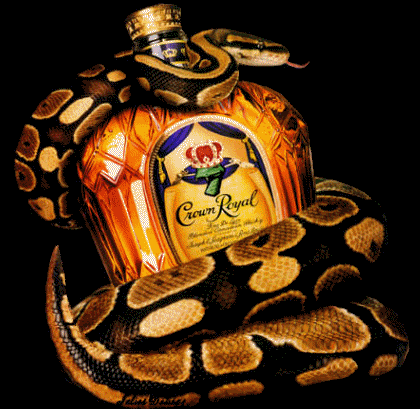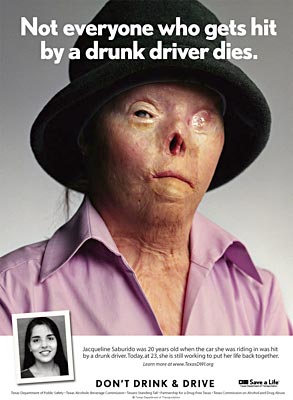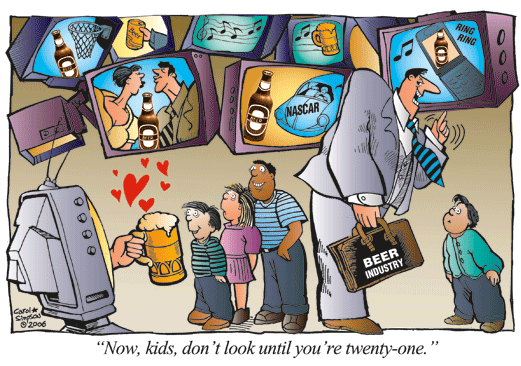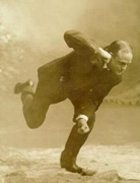QUESTIONS & ANSWERS: ALCOHOL — GENERAL
Liquid Devil

Faces Of Drunk Driving!
Every Face Tells A Story |
Alcohol: Public Enemy #1 (Pastor Castle, MP3)
Ecclesiastes 7:17, “Be not over much wicked, neither be thou foolish:
why shouldest thou die before thy time?”
1. What is drunk driving? This term is an inaccurate characterization of the problems caused by motorists who are impaired by alcohol. The first criminal laws targeting this problem prohibited "drunk driving," encouraging the notion that the problem was restricted to drivers who were visibly drunk. In fact, many alcohol-impaired drivers do not appear drunk in the traditional way. Research has shown that even small amounts of alcohol can impair the skills involved in driving, but the persistent notion that the problem is predominantly one of drunk drivers has allowed many drinking drivers to decide they are not part of the problem. For these reasons, the term "alcohol-impaired driving" is a more accurate and precise description of what is commonly referred to as drunk driving.
2. What does blood alcohol concentration (BAC) measure? A BAC describes the amount of alcohol in a person's blood, expressed as weight of alcohol per unit of volume of blood. For example, 0.08 percent BAC indicates 80 mg of alcohol per 100 ml of blood. For most legal purposes, however, a blood sample is not necessary to determine a person's BAC. It can be measured more simply by analyzing exhaled breath.
3. What BAC is considered illegal? All 50 states and the District of Columbia have per se laws defining it as a crime to drive with a BAC at or above a proscribed level, 0.08 percent.
4. What is the effect of alcohol on driving skills and crash risk? At BACs as low as 0.02 percent, alcohol affects driving ability and crash likelihood. The probability of a crash begins to increase significantly at 0.05 percent BAC and climbs rapidly after about 0.08 percent. For drivers 35 and older with BACs at or above 0.15 percent on weekend nights, the likelihood of being killed in a single-vehicle crash is more than 380 times higher than for nondrinking drivers.1
5. How many drinks does it take to reach significantly impairing BACs? The effects of alcoholic drinks vary greatly because the rate of absorption and BACs attained vary from person to person due to factors such as weight, amount of fat tissue, and stomach contents. Nevertheless, various organizations have developed charts intended to help people estimate their BACs based on the number of drinks consumed. These tables can be used to estimate BACs, but they are subject to error.
6. Are beer and wine less impairing than hard liquor? Impairment is not determined by the type of drink but rather by the amount of alcohol ingested over a specific period of time. There is a similar amount of alcohol in such standard drinks as a 12-ounce glass of beer, a 4-ounce glass of wine, and 1.25 ounces of 80-proof liquor. Beer is the most common drink consumed by people stopped for alcohol-impaired driving or involved in alcohol-related crashes.2
7. What proportion of motor vehicle crashes involves alcohol? The most reliable information about alcohol involvement comes from fatal crashes. In 2004, the National Highway Traffic Safety Administration (NHTSA) estimated that 34 percent of all traffic deaths occurred in crashes in which at least one driver or non-occupant had a BAC at or above 0.08 percent and that some alcohol was present in 39 percent of all fatal crashes and all traffic fatalities.3 Such statistics do not mean that a third or more of all fatal crashes are caused solely by alcohol, because alcohol is only one of several factors that contribute to crashes involving drinking drivers. Furthermore, some fatally injured people in alcohol-related crashes are pedestrians with positive BACs, and these fatalities still would occur even if every driver were sober. Still, alcohol-impaired driving contributes to a significant proportion of fatal crashes.
Alcohol involvement is much lower in crashes involving nonfatal injuries and lower still in crashes that do not involve injuries at all. A study conducted during the 1960s estimated that 9 percent of drivers in injury crashes and 5 percent of drivers in noninjury crashes in Grand Rapids, Michigan, had BACs at or above 0.10 percent.4 A 1977 study found that 12 percent of drivers in injury crashes in Huntsville, Alabama, and San Diego, California, had BACs at or above 0.10 percent, compared with 1 percent of a sample of drivers not involved in crashes.5 According to a research review conducted during this same period, studies of fatally injured drivers found that 40-55 percent had BACs at or above 0.10 percent.6
8. How has the incidence of alcohol-impaired driving changed over time? The incidence of alcohol-impaired driving has been reduced but remains a major problem. NHTSA and the Institute undertook a national roadside breath survey in 1996, patterned after 1986 and 1973 surveys, and found that 83 percent of drivers had no measurable alcohol, a significant increase in nondrinking drivers above the rates of 74 percent in 1986 and 64 percent in 1973.7 In 1996, 7.7 percent of drivers had BACs at or above 0.05 percent, compared with 8.4 percent in 1986 and 13.7 percent in 1973. The proportion of drivers with BACs at or above 0.10 percent was 2.8 percent in 1996, 3.2 percent in 1986, and 5 percent in 1973.
9. Does alcohol-impaired driving differ by driver gender? Crashes among male drivers are much more likely to involve alcohol than those among female drivers. Among fatally injured male drivers of passenger vehicles in 2004, 38 percent had BACs at or above 0.08 percent. The corresponding proportion among female drivers was 18 percent. Alcohol involvement in fatal crashes was highest for males ages 21-40.
According to national roadside breath surveys, more females are driving at night. The proportion of females in weekend nighttime samples of drivers increased from 16 percent in 1973 to 26 percent in 1986 and 31 percent in 1996.7 The increase between 1973 and 1986 was accompanied by a reduction from 3.0 to 1.3 percent in the proportion of female drivers with BACs at or above 0.10 percent. However, between 1986 and 1996, the percentage of female drivers with high BACs increased slightly from 1.3 to 1.5 percent, compared with a decline from 3.9 to 3.5 percent for male drivers.
Between 1982 and 2004, the proportion of fatally injured passenger vehicle drivers with BACs at or above 0.08 percent declined by 32 percent among males and 45 percent among females.
10. When do alcohol-impaired driving crashes occur? They happen at all hours, but alcohol involvement in crashes peaks at night and is higher on weekends than on weekdays. Among passenger vehicle drivers who were fatally injured between 9 pm and 6 am in 2004, 59 percent had BACs at or above 0.08 percent compared with 18 percent during other hours. Forty-four percent of all fatally injured drivers on weekends (6 pm Friday to 6 am Monday) in 2004 had BACs at or above 0.08 percent. At other times the proportion was 25 percent.
11. To whom does the term "hard-core drinking driver" refer? The term was coined to refer to people who repeatedly drive while impaired and are resistant to changing their behavior despite previous sanctions, treatments, or education. The underlying premise is that many, if not most, of these people are problem drinkers.8 The term is not precisely defined, although two criteria commonly used to identify hard-core drinking drivers are prior alcohol-impaired driving convictions and very high BACs (0.15 percent or higher).
12. Are most alcohol-impaired driving crashes caused by repeat offenders? No. It is true that people with prior convictions for driving while impaired by alcohol are overrepresented among drivers in fatal crashes. According to a federal study, drivers convicted of alcohol-impaired driving during the past 3 years are at least 1.8 times as likely to be in fatal crashes as drivers with no prior convictions during the same time period and are at least 4 times as likely to be in fatal crashes in which drivers have high BACs (0.10 percent or higher).9
However, in 2004 only 8 percent of drivers in fatal crashes with high BACs (0.08 percent or higher) had previous alcohol-impaired driving convictions on their records; only 1 percent had two or more convictions. The actual incidence of previous convictions could be higher, because information on convictions was available for only the prior 3 years. In addition, some alcohol offenses are not included on driver records because of court programs that allow drivers to remove or avoid a conviction if they attend educational programs. Still, most alcohol-impaired driving fatal crashes do not involve drivers with a long history of multiple alcohol convictions.
13. Is the problem of alcohol-impaired driving limited to people with very high BACs? No. Among passenger vehicle drivers with illegal BACs (0.08 percent or higher) who died in crashes in 2004, 27 percent had BACs lower than 0.15 percent.
14. Have hard-core drinking drivers been unaffected by countermeasures directed at all drivers? No. It often is suggested that alcohol-impaired driving crashes are increasingly caused by people with very high BACs and repeat offenders. However, between 1982 and 2002, all categories of illegal BACs declined among fatally injured passenger vehicle drivers. Percentage point declines were similar across BACs of 0.08-0.14 percent, 0.15-0.19 percent, 0.20-0.24 percent, and 0.25 percent and higher.10 Similarly, among drivers in fatal crashes with BACs at or above 0.08 percent, the proportion with alcohol convictions during the previous 3 years declined during the past decade from 11 percent in 1994 to 8 percent in 2004. These statistics do not support the claims that hard-core drinking drivers have become a larger part of the problem or that they have been unaffected by countermeasures directed at all drivers.
References
1Zador, P.L.; Krawchuk, S.A.; and Voas, R.B. 2000. Alcohol-related relative risk of driver fatalities and driver involvement in fatal crashes in relation to driver age and gender: an update using 1996 data. Journal of Studies on Alcohol 61:387-95.
2Smart, R.G. 1996. Behavioral and social consequences related to the consumption of different beverage types. Journal of Studies on Alcohol 57:77-84.
3National Highway Traffic Safety Administration. 2005. Traffic safety facts, 2004: alcohol. Report no. DOT HS-809-905. Washington, DC: U.S. Department of Transportation.
4Borkenstein, R.F.; Crowther, R.F.; Shumate, R.P.; Ziel, W.B.; and Zylman, R. 1964. The role of the drinking driver in traffic accidents. Bloomington, Indiana: Department of Police Administration, Indiana University.
5Farris, R.; Malone, T.B.; and Kirkpatrick, M. 1977. A comparison of alcohol involvement in exposed and injured drivers. Report no. DOT HS-400-954. Washington, DC: National Highway Traffic Safety Administration.
6Jones, R.K. and Lacey, J.H. Alcohol and highway safety 2001: a review of the state of knowledge. Report no. DOT HS-809-383. Washington, DC: National Highway Traffic Safety Administration.
7Voas, R.B.; Wells, J.K.; Lestina, D.; Williams, A.F.; and Greene, M. 1998. Drinking and driving in the United States: the 1996 national roadside survey. Accident Analysis and Prevention 30:267-75.
8Simpson, H.M. and Mayhew, D.R. 1991. The hard core drinking driver. Ottawa, Ontario: Traffic Injury Research Foundation.
9Fell, J.C. 1991. Repeat DWI offenders: their involvement in fatal crashes. Washington, DC: National Highway Traffic Safety Administration.
10McCartt, A.T. and Williams, A.F. 2004. Characteristics of fatally injured drivers with high blood alcohol concentrations (BACs). Proceedings of the 17th International Conference on Alcohol, Drugs and Traffic Safety (CD-ROM). Edinburgh, Scotland: Scottish Executive.







